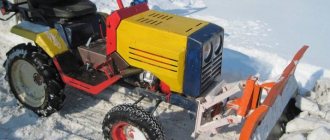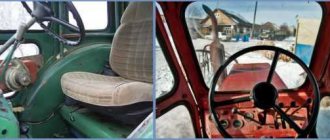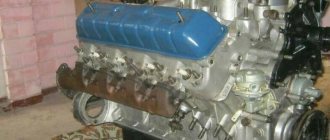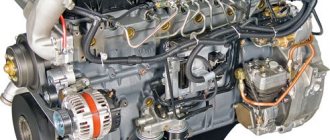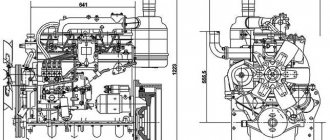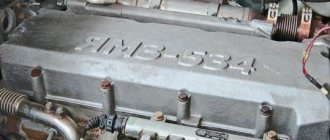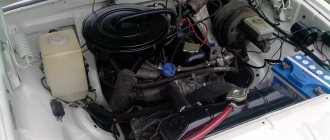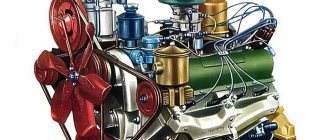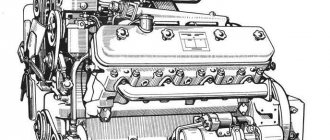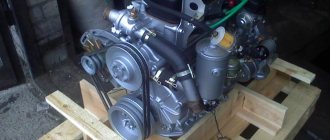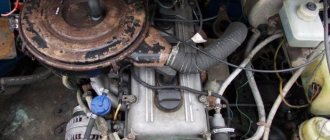The UAZ-469 and UAZ-452 cars were equipped with the UMZ 414 engine. Serial production began in 1978, while production of the UMZ-451M engine continued. Since 1986, UMZ-4146 has been produced. Peculiarities.
The UMZ 414 motor was a further development of the UMZ-451 motor. The 414th engine has no significant differences from the 21st in its main parameters. Its main difference from the GAZ-21 engine is the new design of the cylinder block with increased rigidity.
In addition, the front crankshaft oil seal received an external design. Oil filter from a Zhiguli first model. The lubrication system itself differs from the 451 engine - oil enters the oil cooling radiator through a filter directly from the lubrication channel of the main bearings. The engine is equipped with an oil trap for the crankcase ventilation system. We can say that the 414 engine is a transitional model between the 451 and 417 engines. The compression ratio on the engine is 6.7:1. The power system uses a single-chamber K-131 carburetor. The water pump is attached to the cylinder head. The service life of this engine was increased from 120 to 150 thousand km. The UMZ 414 later served as the basis for the UMZ 417, having received a different cylinder head (similar to the GAZ-24) and a compression ratio of 7.0:1. This engine develops 92 hp.
Characteristics of the UMZ 414 engine
| Parameter | Meaning |
| Configuration | L |
| Number of cylinders | 4 |
| Volume, l | 2,445 |
| Cylinder diameter, mm | 92,0 |
| Piston stroke, mm | 92,0 |
| Compression ratio | 6,7 |
| Number of valves per cylinder | 2 (1-inlet; 1-outlet) |
| Gas distribution mechanism | OHV |
| Cylinder operating order | 1-2-4-3 |
| Rated engine power / at engine speed | 56.6 kW - (77 hp) / 4000 rpm |
| Maximum torque/at engine speed | 172 N m / 2200 rpm |
| Supply system | Carburetor K-129V, K-131, K-131A |
| Recommended minimum octane number of gasoline | 76 |
| Environmental standards | Euro 0 |
| Weight, kg | 165 |
Design
Four-stroke four-cylinder gasoline carburetor with a contact ignition distributor, with an in-line arrangement of cylinders and pistons rotating one common crankshaft, with a lower camshaft.
The engine has a closed-type liquid cooling system with forced circulation. Lubrication system - under pressure and splashing. Aluminum cylinder block with wet cast iron liners. Crankshaft and camshaft from the GAZ-24 engine. A rear packing with a packing holder separate from the last main bearing cap is also used. The inlet valve has a diameter of 44 mm, the exhaust valve has a diameter of 36 mm. A manifold with circular cross-section channels and smooth bends for a single-chamber carburetor. It is worth noting that, depending on the carburetor model and the exhaust setting, the engine developed power in the range of 77-80 hp. 1 - flywheel; 2 — mounting eye; 3 — heater valve; 4 — cylinder head cover; 5 — inlet pipeline; 6 — nuts of studs securing the cylinder head; 7 — valve rocker arm; 8 — rocker axis; 9 — crankcase ventilation pipe; 10 — cylinder head; 11 — valve springs; 12 — oil deflector cap; 13 — valve sleeve; 14 — oil filler cap; 15 - valve; 16 — cylinder head gasket; 17 — coolant pump; 18 — rod; 19 — pusher; 20 — fan pulley; 21 - camshaft; 22 — driven gear of the camshaft drive; 23 — torsional vibration damper; 24 — pulley hub; 25 - pulley; 26 — pulley bolt; 27 - cuff; 28 — drive gear of the camshaft drive; 29 — crankshaft; 30 — oil pan; 31 — cylinder liner; 32 - piston; 33 — oil drain plug; 34 — connecting rod; 35 — oil intake; 36 — oil pump; 37 — cylinder block; 38 — exhaust manifold; 39 — clutch housing.
crank mechanism
The cylinder block
is cast, made of aluminum alloy with replaceable “wet” cast iron liners, liners with the addition of molybdenum.
Aluminum crankshaft support covers, lock where the covers are on the block 4 mm and a head with OVAL windows and M11 studs. The cylinder head
is cast from aluminum alloy, with insertable seats and valve guides, common to all cylinders.
The combustion chamber
is flat-oval, located in the cylinder head.
The pistons
are cast, made of aluminum alloy, tinned, with steel thermostatic inserts poured into them, tinned.
Piston rings:
compression rings: 2, cast iron: upper chrome-plated, lower tinned.
oil scraper: 1, steel, composite. The piston pins
are steel, hollow, floating, secured with two retaining rings.
The connecting rods
are steel, forged, I-section, with a bronze bushing pressed into the upper head.
The crankshaft is
cast, cast iron, 5-support, with counterweights.
The diameter of the main journals is 64 mm, the connecting rod journals are 58 mm. Main and connecting rod bearings
with replaceable thin-walled steel-aluminum liners Thickness, mm: main liner - 2.25;
connecting rod bearing - 1.75; antifriction layer - 0.33. The flywheel
is cast, cast iron, with a pressed-on gear ring for starting the engine with a starter.
Gas distribution mechanism (GRM)
The camshaft is
5-bearing, forged steel.
The camshaft drive
is geared from the crankshaft with a pair of helical gears.
Camshaft bushings
are rolled from steel strip filled with babbitt.
valves
are located parallel to the cylinder axis, tulip-shaped, made of heat-resistant steel 40Х9С2.
disc diameter 44 mm, seat chamfer angle 45°, valve lift height 9.5 mm exhaust discs made of heat-resistant steel 55Х20Г9АН4 with surfacing of the working surface with EP616A alloy, disc diameter 36 mm, seat chamfer angle 45°, valve lift height 9.5 mm. Valve timing, degrees:
opening of the intake valve to TDC.
12 closing the intake valve after i.d. 60 opening of the exhaust valve to b.m.t. 54 closing the exhaust valve after t.m.t. 18 Valve guides are sintered. Valve pushers
are steel, plunger type, with surfacing made of special cast iron.
Push rods
made of aluminum alloy, with pressed steel tips.
The valve rockers are
cast steel with a bronze bushing.
The UAZ 469 was developed for the Soviet army and was used mainly for servicing and transporting command personnel. In the post-Soviet space, this vehicle is quite common, and in the armies of the CIS countries this vehicle is still actively used, despite its age.
Forklift Amkodor 451A
The Amkodor 451A forklift is characterized by durability; it is equipped with a powerful engine and a reliable frame. Difficult working conditions were taken into account during the design, so the machine turned out to be efficient and productive.
The main area of application is loading and unloading materials, transporting them over short distances. The loader is used in ports, airports, railway stations, factories, warehouses, bases, etc.
Photo Amkodor 451A
Return
Features and Benefits
The Amkodor 451A loader can be equipped with standard and extended forks and a crane boom, which expands the scope of use of the machine. Special construction equipment effectively copes with assigned tasks on construction sites, warehouses and ports.
The standard assembly involves installing a 130-liter diesel tank, an adjustable driver's seat, windshield wipers, headlights, and a removable working element.
Return
Technical characteristics and dimensions
The technical characteristics of the Amkodor 451A forklift include:
| curb weight | 7.4 t |
| lifting capacity | 5 t |
| working body lifting speed | 0.24 m/s |
| lowering speed | 0.5 m/s |
| frame angle | 6 degrees forward and 12 degrees back |
| unloading height | 3.3 m |
| turning radius | 3.7 m |
| Climatic performance | U1 |
| operating temperature of the environment | -20/+40 degrees |
The overall characteristics of the Amkodor 451A forklift include:
| length | 3.88 m |
| width | 2 m |
| height | 2.63 m |
| wheelbase | 2.23 m |
| ground clearance | 0.17-0.22 m |
| fork length | 1.2 and 2.3 m |
| overall height with forks raised | 4.23 m |
| free lifting height of the working body | 0.2 m |
dimensions
Return
Engine
To improve the technical characteristics of the Amkodor 451A, the installation of a D-245 engine with a power of 105 horsepower is provided. The 4.75-liter inline-four model is turbocharged. The maximum torque is 384 Nm.
A hydromechanical gearbox with two gears is installed together with the engine. It allows construction equipment to move around the work site at a speed of 20 km/h forward and 11 km/h back.
The advantages of the power unit include endurance. The loader can overcome a slope of up to 20 degrees with a length of 12 m when the working body is fully loaded.
Return
Device
The Amkodor 451A loader is characterized by an attractive appearance, while it is practical. The body design has rounded corners, which ensures the safety of the machine when negotiating turns in densely built areas or in warehouses. Its strength is ensured by the presence of additional stiffening ribs.
Return
Chassis
The high load capacity of Amkodor 451A is due to the use of a strong and reliable frame. A motor, units and power transmission systems, and two axles are installed on it. The driven front axle has a rigid mount, and the steered rear axle is articulated with the ability to swing transversely.
The steering is actuated by a hydraulic system, and the braking system includes multi-disc units in an oil bath. The parking brake is a single-disc dry mechanism with a spring and hydraulic release.
Return
Hydraulic system
The hydraulic system of the Amkodor 451A forklift includes two pumps that operate in conjunction with loading equipment and a steering mechanism. A priority valve for the brake system and a 2-section distributor with direct mechanical control are installed.
Return
Operator's cabin
The advantages of the interior include a large amount of free space, which does not hinder the operator’s movement during work. Safety of work is guaranteed due to wide panoramic glazing.
The driver's seat can be adjusted in several directions, and the ergonomic location of the main controls of the Amkodor 451A forklift has a positive effect on the quality of work.
For ease of access to the salon, two doors are installed, accessed by steps with an anti-slip coating. The work site is illuminated by powerful headlights, so in the dark the working parts remain visible.
All these features allow you to maximize work efficiency and ensure safety at any time of the year or day.
Return
Attachments
The loader copes with the capture of cargo, its transportation and lifting. He copes with work in a warehouse where materials need to be laid and stacked.
The main working element is the forks; they can be standard, 1200 mm long, or extended, 2300 mm long. High productivity is ensured when working in warehouses, bases, ports and industrial buildings.
Return
Modifications
The price of Amkodor 451A depends on the modification, they include:
- 451 A – with duplex forks and unloading height – 3.3 m;
- 451 A-01 – with triplex forks and unloading height – 5 m;
- 451 A-02 - with duplex forks, lifting height - 3.3 m, D-243 engine;
- 451 A-03 – with triplex forks, unloading height – 5 m, D-243 motor.
Return
Cost of new and used
You can buy an Amkodor 451A without mileage for 2.5 million rubles. A used model will cost less – at least 700 thousand rubles.
Source: https://justdepot.ru/articles/skladskaya-texnika/forklifts/4206_vilochnyj-pogruzchik-amkodor-451a/
Specifications
The UAZ 469 vehicles were equipped with a 451MI engine, which was in many ways similar to the Volgovsky ZMZ 402. The UAZ 469 engine replaced the outdated GAZ-69 as a modernized vehicle. During development, many design features were taken from the GAZ-21 and GAZ-24.
In parallel with this, a civilian version of the car was produced with the marking 469B, which was renamed in 1985 and received the marking UAZ 31512.
Let's consider the main technical characteristics of the UAZ 469 engine, as well as the device:
UAZ-451MI
UAZ-4178
ZMZ-4021.10
Existing types of bridges
Improved bridges on UAZ
- Managed. This is, as a rule, the front axle of the car, equipped with either rear-wheel drive, which is outdated today, or all-wheel drive. But there is another option: in transport equipment for public utilities or agriculture, it is the rear axle that is steered, not the front axle. This type of design is divided into two subtypes.
- Uncut. This is a special beam equipped with a mechanism for steering knuckles, fixed on the sides; wheel hubs are placed on the knuckles. The purpose of this design is to control the rotation of the wheels while driving. The most important conditions are the lightness and strength of the continuous beam. That is why, as a rule, it is made of high-strength steel using forged technology.
- Split. This is already a gearbox equipped with drive shafts. The purpose of the cutting mechanism is to transmit torque to the wheels. The split bridge provides ample opportunities for vehicle maneuvering.
- Supportive. This design is used to increase the lifting power of the machine and acts as an additional supporting element. Without this part, a car designed to transport large cargo would simply fall apart within the first kilometer. The support device can be found in such a unique vehicle as a motor home.
- Continuous leader. This is a rather complex structure, consisting not only of a beam, but also axle shafts, bearings, and a differential. On the beam of this design springs and brackets are attached to secure the suspension. Thanks to the continuous drive axle, the drive wheels can rotate at different rates, in addition, the design softens the load and controls the car when cornering. Some bridge parts undergo additional processing to give them greater strength and elastic properties. Thus, the axle shafts are made of high-quality steel and then hardened with high-frequency heat.
Service
Maintenance of the power unit on the UAZ 469 is carried out according to the standard scheme. Thus, the service interval is 15,000 km before the first major overhaul. After restoring the engine, it is recommended to carry out maintenance every 10-12 thousand km in order to preserve the life of the engine.
During maintenance, the engine oil and oil filter are changed. So, mostly car enthusiasts like to pour mineral or cheap semi-synthetic oil into the engine. Moreover, if you take mineral water, then it is not of the best quality that ends up in the power unit.
Every second for a UAZ engine is a comprehensive replacement of consumables. In it, the vehicle owner must perform the following technical work:
- Change oil and filter element.
- Replacing the fuel filter.
- Cleaning the carburetor.
- Replacing the air filter element.
- Checking the spark plugs.
- Adjusting the valve mechanism.
- Checking gaskets for breakdown.
History[edit | edit code]
The Ulyanovsk Automobile Plant developed a new family of light trucks, vans and ambulances of the UAZ-450 family in the mid-1950s. Their production began in 1958. The main feature of the new cars, in addition to the innovative carriage layout, was also all-wheel drive, since these cars were developed, including taking into account the requirements of the army. Meanwhile, the national economy of the USSR experienced a shortage of light delivery vehicles with a carrying capacity of up to 800-1000 kg. The Moscow Small Car Plant produced vans based on Moskvich cars, but their load capacity was only 250 kg. On the other hand, with the discontinuation of the legendary “lorry” in 1950, the lightest truck became the 2.5-ton GAZ-51 [ source not specified 581 days
].
The national economy, especially in urban conditions, did not require all-wheel drive; cars with rear-wheel drive were easier to maintain, so in the late 50s, with the launch of the all-wheel drive UAZ family, the development of a rear-wheel drive family began. In accordance with the Resolution of the Council of Ministers of the RSFSR dated January 7, 1958, the Department of the Chief Designer of the Ulyanovsk Automobile Plant developed a technical design for a family of rear-wheel drive cars. It received a general index of 451. As in the case of the 450 family, the “451” family included: an all-metal van - UAZ-451
, flatbed truck -
UAZ-451D
, minibus -
UAZ-451V
. All modifications of cars, except the minibus, were put into production in 1961.
The main drawback that had to be “overcome” during the design of the new platform was the overload of the front axle. If in the all-wheel drive version one of the two drive axles was underloaded, which was not so critical, then in the rear-wheel drive configuration the only one was stuck. This was confirmed in practice - in 1958, the SKB of the Ulyanovsk Automobile Plant produced two experimental models based on the UAZ-450 - front-wheel drive and rear-wheel drive cars. Both options had to be rejected precisely because of problems with weight distribution. As a result, for future 451s, it was decided to keep the base but move the front end of the engine block 220 mm back. The base was left the same, and the engine, sacrificing the unification of the hood and engine compartment, was moved back and slightly (by 73 mm) down.
Design option for the front part of the UAZ-451 produced in 1961-1965.
In 1965, the family was modernized, resulting in modifications: UAZ-451M, UAZ-451DM. The main external difference from previous cars was the updated exterior of the front end with a trapezoidal radiator grille. Instead of an engine similar to the Pobeda car, a more powerful one from the 21st Volga began to be installed. In the early 1970s, the power of the engine, already mastered by the Ulyanovsk Motor Plant (UMZ), was increased from 70 to 75 horsepower. The carrying capacity has also increased from 800 to 1000 kg. With the development of production of the new UAZ-469 SUVs on all Ulyanovsk trucks, work began on replacing lever shock absorbers with telescopic ones. In parallel with this, in the early 1970s, a modernization program for families of cabover UAZ vehicles was developed, but for a number of reasons it was constantly postponed. In 1979, new lighting devices meeting UNECE requirements were introduced on vehicles of the 451 and 452 families. In 1982, cars of the UAZ-451 family were discontinued.
Tuning
Tuning the UAZ 469 engine with a volume of 2.5 liters is carried out by analogy with the engine produced by ZMZ 402. Since the designs are similar, tuning the power unit is quite simple.
To increase power characteristics, it is necessary to bore the cylinder block to dimensions of 95 mm. In this case, lightweight pistons and a crankshaft are installed in the engine. To ensure maximum effect, it is recommended to change the cylinder head to an injection one and, accordingly, install an electronic fuel injection system.
Do not forget that lightweight valves and guide bushings should be installed in the new cylinder head. All this will make the engine lighter by several tens of kilograms.
To prevent the power unit from overheating during operation, a cooling system kit is installed, which includes a sports pump and silicone pipes for the engine cooling system.
Instead of the original copper radiator, you need to mount a lightweight three-row aluminum one. Also, you will have to change the high-voltage wires and the ignition system. A separate item is the installation of a new clutch kit, as well as changing the ignition box.
Story
The Ulyanovsk Automobile Plant developed a new family of light trucks, vans and ambulances of the UAZ-450 family in the mid-1950s. Their production began in 1958. The main feature of the new cars, in addition to the innovative carriage layout, was also all-wheel drive, since these cars were developed, including taking into account the requirements of the army. Meanwhile, the national economy of the USSR experienced a shortage of light delivery vehicles with a carrying capacity of up to 800-1000 kg. The Moscow Small Car Plant produced vans based on Moskvich cars, but their load capacity was only 250 kg. On the other hand, with the discontinuation of the legendary “lorry” in 1950, the lightest truck became the 2.5-ton GAZ-51 [ source not specified 837 days
].
The national economy, especially in urban conditions, did not require all-wheel drive; cars with rear-wheel drive were easier to maintain, so in the late 50s, with the launch of the all-wheel drive UAZ family, the development of a rear-wheel drive family began. In accordance with the Resolution of the Council of Ministers of the RSFSR dated January 7, 1958, the Department of the Chief Designer of the Ulyanovsk Automobile Plant developed a technical design for a family of rear-wheel drive cars. It received a general index of 451. As in the case of the 450 family, the “451” family included: an all-metal van - UAZ-451
, flatbed truck -
UAZ-451D
, minibus -
UAZ-451V
. All modifications of cars, except the minibus, were put into production in 1961.
Important Features and technical characteristics of a cargo tow truck with a MAN manipulator (MAN)
The main drawback that had to be “overcome” during the design of the new platform was the overload of the front axle. If in the all-wheel drive version one of the two drive axles was underloaded, which was not so critical, then in the rear-wheel drive configuration the only one was stuck. This was confirmed in practice - in 1958, the SKB of the Ulyanovsk Automobile Plant produced two experimental models based on the UAZ-450 - front-wheel drive and rear-wheel drive cars. Both options had to be rejected precisely because of problems with weight distribution. As a result, for future 451s, it was decided to keep the base but move the front end of the engine block 220 mm back. The base was left the same, and the engine, sacrificing the unification of the hood and engine compartment, was moved back and slightly (by 73 mm) down.
Design option for the front part of the UAZ-451 produced in 1961-1965.
In 1965, the family was modernized, resulting in modifications: UAZ-451M, UAZ-451DM. The main external difference from previous cars was the updated exterior of the front end with a trapezoidal radiator grille. Instead of an engine similar to the Pobeda car, a more powerful one from the 21st Volga began to be installed. In the early 1970s, the power of the engine, already mastered by the Ulyanovsk Motor Plant (UMZ), was increased from 70 to 75 horsepower. The carrying capacity has also increased from 800 to 1000 kg. With the development of production of the new UAZ-469 SUVs on all Ulyanovsk trucks, work began on replacing lever shock absorbers with telescopic ones. In parallel with this, in the early 1970s, a modernization program for families of cabover UAZ vehicles was developed, but for a number of reasons it was constantly postponed. In 1979, new lighting devices meeting UNECE requirements were introduced on vehicles of the 451 and 452 families. In 1982, cars of the UAZ-451 family were discontinued.
Conclusion
UAZ engines are considered one of the most reliable and quite common, both in the military industry and in civilian practice. Maintenance and repair of the power unit is carried out quite easily and simply with your own hands, thanks to its simple design. Recently, it has become fashionable to tune old Soviet vehicles. This point was not spared by the motor for the UAZ 469.
The UMZ 451 engine was intended to power UAZ off-road vehicles with a gross weight of 3.5 tons, such as UAZ-469 and UAZ-452, and trucks with a carrying capacity of up to 1.5 tons. Peculiarities.
The UMZ 451 engine is practically an engine with minor changes. The crankshaft and camshaft are from GAZ-21, the main bearing caps are aluminum, the rear cover is cast integrally with the rear oil seal housing (packing is used). The water pump is installed on the cylinder head. The diameter of the intake valve cap is 44 mm, the exhaust valve is 36 mm. The UMZ-451M already uses the crankshaft and camshaft from the GAZ-24 engine (identical main bearings). Unlike and, the UMZ 451 has rectangular channels in the cylinder head, and the collectors themselves are also “square”. A single chamber carburetor is used. Just like on all UMZ engines, a “Zhiguli” oil filter is installed on the engine. UMZ-451MIE is an engine with a shielded ignition system. The service life of the UMZ 451 motor is about 150-200 thousand km.
Ski-tracked snowmobile UAZ-451S
Maxim Shelepenkov, photo UGC UAZ
In 1956, a Special Design Bureau (SKB) was organized at the Ulyanovsk Automobile Plant to develop products for the national economy and special purposes based on cars and units of serial production. The bureau was headed by Grigory Ivanovich Krasilnikov.
In 1961, the Ulyanovsk Automobile Plant received the task to develop a ski-tracked snowmobile (Resolution of the USSR Council of Ministers of November 5, 1960). Work on the snowmobile began at SKB in April 1961, V.F. was appointed lead designer. Kazyukhanov.
According to the project, the standard Ulyanovsk truck UAZ-451D (UAZ-451S) or UAZ-452D should be equipped with replaceable snowmobile equipment. Instead of front wheels, all-metal welded skis with soles made of thin-sheet stainless steel were installed. Instead of the rear ones, there are caterpillar movers with drive sprockets engaging a rubber track reinforced with a steel cable and channel-type steel lugs. At the same time, the drive axle of the caterpillar propulsion unit remained as unified as possible with the serial one, differing from it in the length of the axle shafts and casings and the absence of brakes.
Drawings for the construction of the first model were issued in July 1962; the total weight of the new chassis was only slightly greater than the usual wheel travel. In this configuration, the car was able to move on snow-covered roads and virgin snow of considerable depth. With dense snow cover and the presence of crust, the depth of the snow cover no longer mattered - the snowmobile had a small specific pressure on the snow. In the absence of snow cover, the replaceable equipment could be removed from the vehicle, and it turned into a regular one on wheels, which made the vehicle all-season. True, the changeover to skis had to be done in the field, since the car needs snow to move on skis, and the changeover of the tracked mover had to be done in a garage, since this requires additional lifting mechanisms.
Based on the results of factory tests, the design was refined and the following UAZ-451S samples were manufactured, now for interdepartmental testing.
Interdepartmental tests of two UAZ-451S samples were carried out in 1965–1966. The tests in 1966 also included a two-month demonstration run along the route Novosibirsk - Omsk - Petropavlovsk - Kustanai - Dzhetygora - Aktyubinsk - Uralsk - Kuibyshev - Ulyanovsk (Siberia, Kazakhstan, central Russia), the total distance was more than 4000 km. After Uralsk, the snow cover unexpectedly ended, the cars had to be converted to wheel-tracked travel and the run ended by making our way on snowmobiles into the mud. During the run, it was mainly the track tracks that failed, which regularly failed, but not a single breakdown of the chassis was recorded.
| Curb weight, kg | 2113 |
| Total weight, kg | 3063 |
| Load capacity, kg | 800 |
| Ski width, mm | 340 |
| Track width, mm | 390 |
| Specific pressure on snow with full load, kg/cm2: | 0,116 0,132 |
Maximum speed, km/h:
| 48 15–20 |
In 1968, new samples of the UAZ-451S were manufactured using slightly revised documentation to increase the mileage of tracked propulsion systems (belts and rollers). In the same year, operational tests of the UAZ-451S began, one sample was sent to the Tambov region to the agricultural experimental station, to the Tatar Autonomous Soviet Socialist Republic and to the city of Buguruslan (Orenburg region).
Based on the results of operational and subsequent life tests, it was decided to make not just a snowmobile, but an all-weather machine with an articulated frame. To do this, the frame from the UAZ-452D production car was supposed to be divided into two parts and control hydraulic cylinders were installed at the joint to allow the machine to turn. With such a frame design, it would be possible to install a caterpillar track on the vehicle not only on the rear axle, but also on the front axle, which would dramatically increase the capabilities of the vehicle.
Most of the design documentation had already been prepared for the new snowmobile, but in January 1971, at the direction of the chief designer of the plant, all work on snowmobiles at SKB was stopped.
Characteristics of the engine UMZ 451/451M UAZ-469, Bukhanka
| Parameter | Meaning |
| Configuration | L |
| Number of cylinders | 4 |
| Volume, l | 2,445 |
| Cylinder diameter, mm | 92,0 |
| Piston stroke, mm | 92,0 |
| Compression ratio | 6,7 |
| Number of valves per cylinder | 2 (1-inlet; 1-outlet) |
| Gas distribution mechanism | OHV |
| Cylinder operating order | 1-2-4-3 |
| Rated engine power / at engine speed | 51.5-55.0 kW - (70-75hp) / 4000 rpm |
| Maximum torque/at engine speed | 170 N m / 2200 rpm |
| Supply system | Carburetor K-129V |
| Recommended minimum octane number of gasoline | 72, 76 |
| Environmental standards | Euro 0 |
| Weight, kg | — |
Service
Changing the oil in the UMZ 451 engine.
Oil change interval - 10 thousand km.
The oil volume of a dry engine with an oiled radiator is different for UMZ-451 and UMZ-451M! The first has 6.2 liters, the second - 5.8. Please note that there is always 0.5 to 1 liter of oil remaining in the lubrication system and radiator. The oil filter on the UMZ-451M is from the VAZ 2101, on the UMZ-451 it is the same as on the GAZ-21 (ratchet). The oil recommended by the manufacturer is M-8-V SAE 15W-20, M-6z/12G SAE 20W-30, M-5z/10g1, M-4z/6B1 SAE 15W-30. Valve adjustment
It is necessary to adjust the gaps every 15 thousand km.
Engine 414 is the next generation of the UMZ 451 power unit. The engine was installed on UAZ-469 and UAZ-452 vehicles. Intended for import to warm and tropical countries.
UlZIS-253
The first prototype of the UlZIS-253 diesel truck was created in May 1944. At the end of 1944, all work to prepare for the production of this vehicle was transferred to the Novosibirsk Automobile Plant (NAZ) under construction, the planned production volume of which was 100 thousand trucks per year. According to the project, NAZ was supposed to become the leading manufacturer of diesel trucks in the USSR - what KamAZ, built 30 years later and also “from scratch,” subsequently became. But the only truck model that was offered for production was the UlZIS-253 developed in Ulyanovsk, renamed NAZ-253. However, the NAZ management refused to deal with this car. From a note addressed to Deputy Minister V.F. Garbuzov, May 1946: “NAZ-253, formerly UlZIS-253, is a 4-ton two-axle vehicle of the ZIL-150 class. In terms of efficiency, it has no special advantages over the ZIS-150. Due to operating conditions (off-road) it is not suitable for Siberia - low cross-country ability. We consider it advisable to develop a three-axle vehicle with a load capacity of at least 5-6 tons. Chief designer of NAZ Shaposhnik.” (The similarity of this car with the future KamAZ - a three-axle heavy-duty diesel truck is noticeable.) After some time, Moscow gave the green light to the creation of a new car and a new engine. Work on NAZ-253 was curtailed. And then, quite unexpectedly, on September 26, 1948, the Council of Ministers of the USSR decided to liquidate the Novosibirsk Automobile Plant. Experimental production, design department and development of diesel engines were transferred to the Minsk Automobile Plant, specialists were distributed among automobile plants - Minsk, Ulyanovsk, Chelyabinsk. NAZ workers were transferred to the new owner of the 335th site - the Novosibirsk Chemical Con Plant src=»https://allautopark.ru/wp-content/uploads/8/0/2/80201aa75b26d26d0876115a80bb303f.jpe» class=»aligncenter» width=»400″ height=”260″[/img]Ul ZIS?-253
Important Technical characteristics of a motor grader from the Japanese manufacturer Komatsu
Ul ZIS?-253
Specifications
As mentioned earlier, the 414 power unit was developed on the basis of the UMZ 451. It has been modernized and refined, and accordingly has greater technical characteristics than its predecessor.
The engine uses: a new design intake pipe, a cylinder head with improved intake and exhaust channels, an increased performance oil pump, a closed crankcase ventilation system, parts and components of increased reliability and wear resistance.
The products were awarded the State Quality Mark. UMZ-414 engines were produced until 1986.
Let's consider the technical characteristics of UMZ 414:
Motor device
The design features of the motor differ slightly from the UMZ-451. The units and parts have the same location. Let's look at the motor design:
1 - flywheel; 2 — mounting eye; 3 — heater valve; 4 — cylinder head cover; 5 — inlet pipeline; 6 — nuts of studs securing the cylinder head; 7 — valve rocker arm; 8 — rocker axis; 9 — crankcase ventilation pipe; 10 — cylinder head; 11 — valve springs; 12 — oil deflector cap; 13 — valve sleeve; 14 — oil filler cap; 15 - valve; 16 — cylinder head gasket; 17 — coolant pump; 18 — rod; 19 — pusher; 20 — fan pulley; 21 - camshaft; 22 — driven gear of the camshaft drive; 23 — torsional vibration damper; 24 — pulley hub; 25 - pulley; 26 — pulley bolt; 27 - cuff; 28 — drive gear of the camshaft drive; 29 - crankshaft; 30 — oil pan; 31 — cylinder liner; 32 - piston; 33 — oil drain plug; 34 — connecting rod; 35 — oil intake; 36 — oil pump; 37 — cylinder block; 38 — exhaust manifold; 39 — clutch housing.
Hinge
The constant angular velocity joint is located in the inner cavity of the steering knuckle. This mechanism corresponds to the specified angular velocities between the drive and driven shafts, which are constantly changing
It is important to keep this angle the same regardless. The front axle hinge of the UAZ-469 consists of two forks
Four balls are placed in grooves of a curved configuration.
The fifth ball is placed in the central sockets of the forks. This is an installation element, its function is to center the forks. The longitudinal movement of the hinge is limited by ball bearing 10 and thrust washers 25 and 26. The drive fork of the hinge located inside is connected by splines to the differential side gear.
At the end of the outer driven fork there is a drive gear 21 of the wheel reducer. It is mounted on splines that serve only the steering knuckle. The roller bearing is also located here. At the same time, these parts are locked with nut 19. The driven gear of the internal gearbox is bolted to shaft 11.
Modifications
In addition to the original power unit, there were several modifications with modifications:
| Engine designation according to design documentation | VDS-descriptive part of the marking | Characteristic features of the completeness and design of the engine | Applicability on car |
| Equipment with carburetor | |||
| 414-1000400 | Car engine with 1-chamber carburetor | UAZ | |
| 41417-1000400 | Automotive engine with shielded electrical equipment and a 1-chamber carburetor in export version | ||
| 4141-1000400 | Automotive engine with shielded electrical equipment and a 1-chamber carburetor for domestic supplies | ||
| 4142-1000400 | Car engine with 2-chamber carburetor | ||
| 41436-1000400 | Automotive engine with shielded electrical equipment and a 2-chamber carburetor in export version | ||
| 4143-1000400 | Automotive engine with shielded electrical equipment and 2-chamber carburetor for domestic supplies | ||
| 4144-1000400 | Car engine with 2-chamber carburetor (compression ratio 8.2) | ||
Production dates:
- UMZ-414, 4141, 4142, 4143, 4144 start of production 01/16/1980
- UMZ-4147 production start 10/14/1985 to 03/12/1993
- UMZ-4146 production start 05/11/1986 to 03/12/1993
- UMZ-4149 production start 08/19/1987 to 08/30/1989
Service
Servicing the engine is quite simple. Thus, scheduled maintenance is carried out every 15,000 km. Maintenance includes changing the oil and filter. To change the oil, you will have to unscrew the drain plug and wait for the lubricant to drain. Then, the plug is screwed in and oil is poured through the filler neck. The oil filter is changed when there is no oil in the engine.
Maintenance also includes checking all systems for oil leaks and malfunctions. Every 30,000 km the valves must be adjusted, and every 20,000 km the air filter element must be replaced.
